The Bolas Arc, Part 2
Last week, I began telling the story of how the Bolas Arc (the three-year stretch from Kaladesh to War of the Spark with a connected story involving the Elder Dragon Planeswalker as antagonist) came to be. If you haven't read last week's article, I recommend doing that before continuing, as I'm going to pick up right where I left off.
Back at our big meeting, we'd spent some time talking about our top candidates for new and return Planes. When we broke for lunch, we had the following written on the white board:
Block #1: Kaladesh, Ixalan, or Amonkhet
Block #2: Kaladesh, Ixalan, or Amonkhet
Block #3: Kaladesh, Ixalan, or Amonkhet
Block #4: Return to Dominaria
Block #5: Ravnica (Guild block)
Block #6: Planeswalker War (on Ravnica)
Remember that this was back under the two-and-two model where each year had two blocks, each with a large and a small set both occurring on the same Plane. We knew our six Planes, but didn't quite know the order for all of them yet. The discussion after lunch was to look at each setting and make sure we had a creative and mechanical take on them. This was important because we wanted to make sure we had confidence in each Plane before we pitched the whole plan to upper management. I don't remember the order in which we discussed them, so I'm just going to go alphabetically.
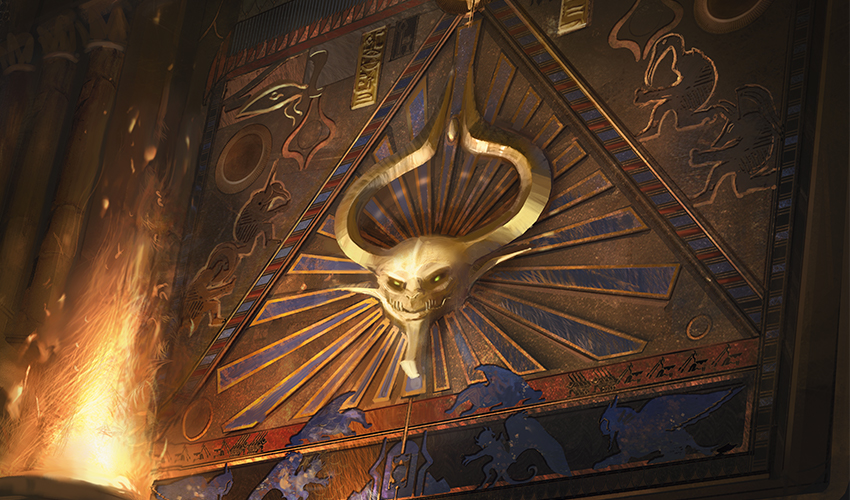
Amonkhet
Clearly this was going to be a top-down set based on Egyptian mythology. The Creative team members brought up the following issues:
- We had done Theros not too long ago and needed to make sure that the two sets felt distinct as there were a bunch of things, like gods, that overlapped the two source materials.
- Egyptian mythology had a very strong visual iconography, but as I talked about last week, there was a concern that Egyptian tropes broke into two categories—sunny, living Egypt and dusty, dead Egypt—and we couldn't do both.
- Egyptian mythology has a lot of desert components, which are bland and very similar looking. Was there an answer for how to incorporate those while keeping the Plane visually interesting?
The one idea that came up that showed promise was the idea of this Plane being shaped by Bolas, with Bolas being their head god. Incorporating elements of Bolas would help give this world a Magic edge. Mechanically, I said we would lean on the top-down nature of the world. I assumed we'd probably do tribal mummies (as Zombies) and would look for a mechanic or two that played up Egyptian mythological tropes. I liked the idea of this being Bolas's world as it would help give the Plane a feel we could mechanically capture. My issues were:
- Egyptian mythology was just way less known than Greek mythology. I was worried there would be less opportunity for top-down card designs based upon it.
- I knew we would need to incorporate deserts in some way, but I wasn't eager to bring back the card Desert as the gameplay wasn't good.
- We'd had some issue with the Theros Gods. We'd have to find ways to address the new Gods while still making them feel like Gods.
All in all, we were pretty confident we could make this world work.
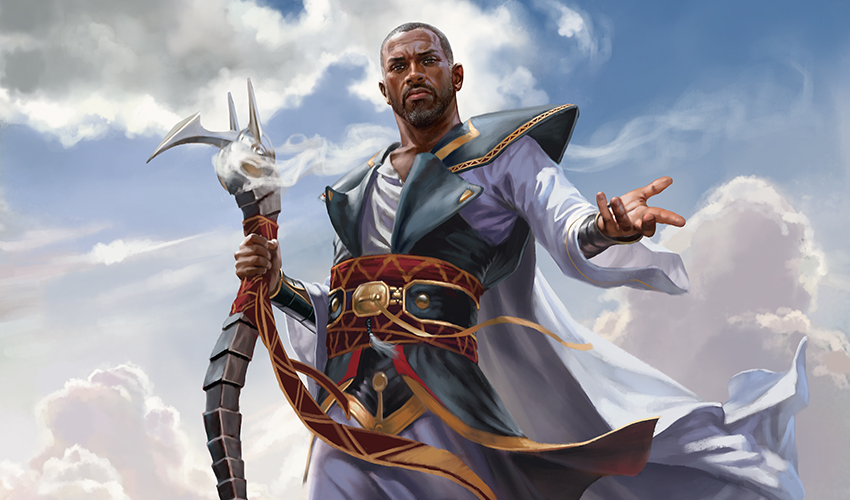
Dominaria
Usually, the issue with a Plane is finding enough things to do with it. Dominaria had the exact opposite problem. We'd spent most of the first ten years of Magic on Dominaria. Creatively and mechanically, it represented a whole bunch of things, but modern Magic Planes need to have a singular identity. Could we find a way to express what made Dominaria special in a way that wasn't just a hodgepodge of unconnected things? On top of that, here were the Creative team's issues:
- The last time we had visited Dominaria (back in Time Spiral block), it was a post-apocalyptic nightmare. It was depressing, and the audience didn't particularly like it. Was there a way to make it more hopeful and less dreary?
- Dominaria was too big to visit everything the audience knows exists on the world. Where exactly were we supposed to focus?
- Likewise, there were many unresolved narrative threads that connected to Dominaria. Which ones were we supposed to connect to this story?
The Creative team pointed out that unlike most Planes, returning to Dominaria would require a lot of research. There was a ton of information that would have to be gathered and sorted through. Here were my mechanical issues:
- Because Dominaria was the early days of Magic, we'd already mined the useful mechanical elements. This meant the nostalgia would have to be covered more by individual card designs than mechanics.
- The enfranchised audience would want us to revisit the thing they love most about Dominaria, but there were just too many things to fit them all in the set. We were going to leave out stuff that some players would expect to be there.
- There was going to be pressure to have the design feel more like early Magic, as that's what players associate with Dominaria. I didn't want to redo things we'd purposefully moved away from to improve the game just for nostalgia's sake. We'd made that mistake with Time Spiral, to our detriment.
We all knew that this was going to be a big challenge to execute, but returning to Magic's original home Plane on its 25th anniversary just seemed too cool not to do.
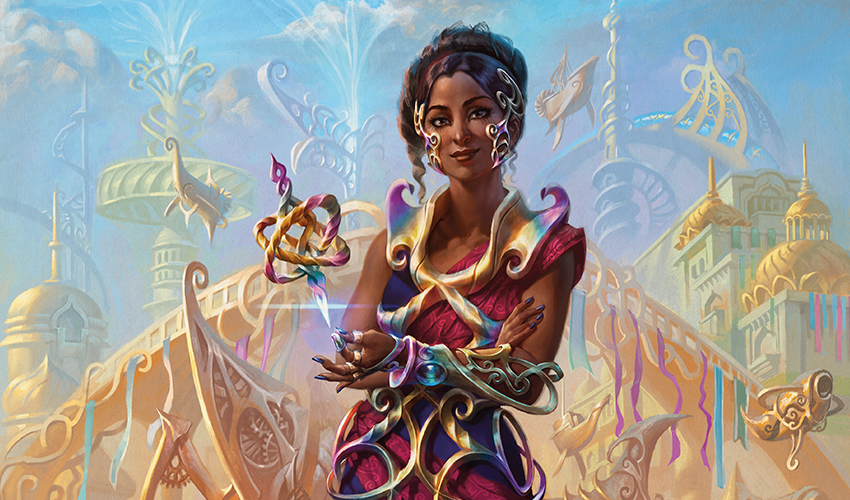
Kaladesh
Because Kaladesh had been done in Magic Origins, we had a bit of a head start on this Plane. We knew it was a lighter, brighter take on steampunk and that it had an Indian vibe. The Creative team had put extra resources on Magic Origins to make sure they were building a Plane we could support with a whole block.
The bigger question was the mechanical take on the setting. I'd worked with Shawn Main, who had led the design of Magic Origins, to make sure we chose a mechanical identity we could revisit when we went to Kaladesh. Shawn and I had agreed on caring about artifacts, so I knew that this was going to be an artifact-centered block. We hadn't done one of those since Scars of Mirrodin, so I knew there would be some appetite for it. The idea I really latched onto was focusing on invention. I knew the Plane was brighter and happier than our other artifact worlds, and I liked the idea of leaning into a bit more of a Johnny/Jenny sensibility that played up artifacts as doing weird and quirky things you could build around. My pitch was that we'd make something more modular where the pieces could fit together in various ways. I wasn't quite sure how to execute on that, but it excited me as a jumping-off point for design.
This was one of the Planes we were most confident about, as both creative and design had a very good sense of where we were going.

Ixalan
This was definitely the Plane with the most questions. Jenna Helland (with help of others on the Creative team) had done a lot to flesh out the setting, but there was still a lot of unknowns to be addressed. Here were the issues from the Creative team:
- The shard of Naya had used a bunch of similar source material. Ixalan needed to make sure it had its own feel and didn't just seem like more Naya.
- There were a lot of questions about the look and feel of the natives of the continent being attacked by the vampires.
- The Plane had a built-in conflict, but how was the larger story going to tie in? Ixalan seemed the most disconnected from the Multiverse.
The Creative team felt they could solve all these problems though. The bigger issue was that I had no idea what the world wanted to do mechanically. It didn't lend itself to a top-down design, which meant I needed something structural to build around. One of the ideas I'd pitched earlier when I was talking about mechanical ideas without a home was my desire to riff on a mechanic Richard Garfield had made in the Vampire: The Eternal Struggle trading card game called "the edge." It was a game piece that granted a player extra abilities, but the game piece could be stolen by other players. I thought the idea of a resource that is fought over through gameplay was compelling, and was interested in finding a home for it.
Also, we had recently done Battle for Zendikar as a two-sided conflict, and I wasn't interested in doing another one so soon. Putting these two ideas together, I had a proposal. What if we added a third faction to the Plane and, instead of two factions fighting, we had three factions fighting over a resource (or possibly resources) that we would represent with an edge-like mechanic? The Creative team said they would look into how to add a third faction.
We felt that was enough to sign off on this Plane. We were aware that it was going to be the hardest sell of the Planes we were proposing.

Ravnica (Guild Model)
I've divided this up into two sections—the guild-model block and the Planeswalker war block. The guild-model block was very straightforward. We would do what we did in Return to Ravnica and Gatecrash and just not have a Dragon's Maze (which hadn't performed all that well). This meant the block would have two large blocks instead of a large and a small. No one felt this was going to be an issue (little did we know that the whole structure would change to this before we got there).
The one idea that came up was that this could represent the part of the story where Nicol Bolas messes with the Plane of Ravnica. The Creative team liked the idea of a cold war feel where Bolas slowly gained influence over a number of the guilds.
This was going to be a guild block, which meant mechanically, I had a strong idea of how we'd execute it. Of all the blocks we talked about, this was the one we spent the least amount of time on. We were creating a lot of challenges for ourselves. We felt it was okay to have one block that was more a repeat of the past. Everyone had total confidence that we could get sign-off on this.
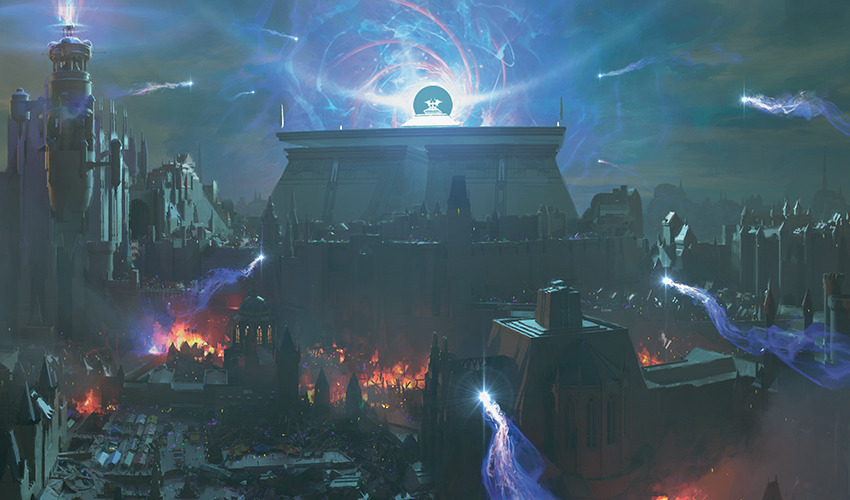
Ravnica (Planeswalker War)
This block had a few big challenges. First, we were staying on the same world for two back-to-back blocks. We had to defend that. Second, we were pitching this as a block built around an event rather than a Plane (I'd dubbed it an "event block"). This was a new idea, so we had to understand what exactly that meant. Third, how much Ravnica had to be in this block that wasn't about Ravnica? That too had to be figured out.
The Creative team's biggest issue was how to communicate a sequential plot on random cards. This was going to be the big challenge for them, but one they felt they could tackle.
Mechanically, I also had a big ask. We were about to make a Planeswalker war. Normally, in a block, I got five planeswalkers. How exactly was I going to convey a Planeswalker war in a large set with three planeswalkers or a small set with two? Also, I felt I needed to mechanically sell the idea that this was an event block. I didn't even know what that meant, but I vowed to figure it out.
Of all the blocks, this seemed like the easiest one to sell to upper management (I mean, it sounds pretty awesome in a one-sentence pitch), but one of the hardest to execute. I remember Aaron Forsythe, my boss, asking me if I felt I could mechanically pull this off. I said, "I'll figure it out."
We then started talking about the order of the six blocks. The last three were already locked in, so we needed to figure out what order we wanted for Amonkhet, Kaladesh, and Ixalan. I think we decided to put Ixalan third because it was the Plane we felt needed the most work and putting it last allowed us the most time to work on it. We ended up choosing to put Amonkhet first because it seemed like putting a fan-favorite choice in starting position would start off the arc with a bang. So, here is what we were going to present as the three-year arc:
Block #1: Amonkhet
Block #2: Kaladesh
Block #3: Ixalan
Block #4: Return to Dominaria
Block #5: Ravnica (Guild block)
Block #6: Planeswalker War (on Ravnica)
It had been a long day, but we had our arc.
Making It Happen
The pitch to upper management went pretty well. Their biggest sticking points were Ixalan and the Ravnica guild block. They wanted us to spend more time fleshing out Ixalan and pushed back on staying on Ravnica for a full year. We agreed to the first demand and argued about the second one. We felt strongly that the audience would expect a guild block if we returned to Ravnica and knew we couldn't have the Planeswalker war also be a guild block. Eventually, we got them to come around and agree to the fifth block being on Ravnica.
Here's what happened as we actually went about making each of the blocks:
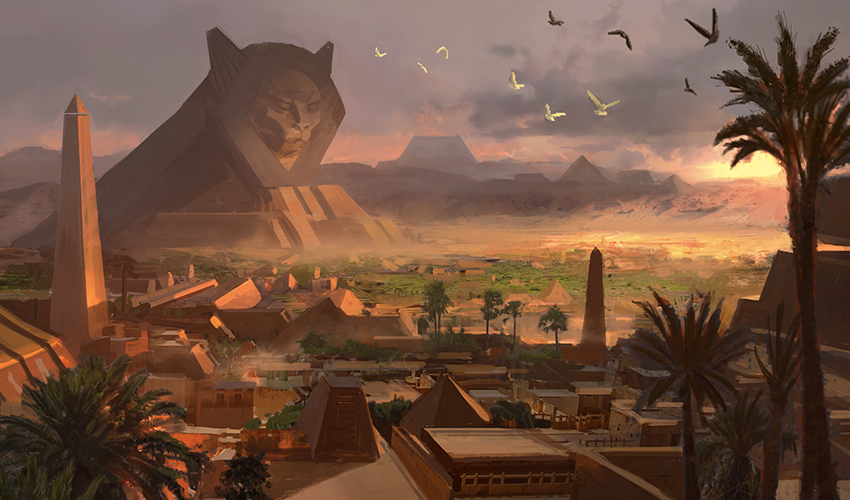
Amonkhet
We were halfway through exploratory design (about three months in, as this process took six months back then) when a bunch of questions were raised about Amonkhet block. First off, the story was starting to come together, and it felt like having Bolas defeat the Gatewatch on "his" Plane made more narrative sense. Second, Shadows over Innistrad block was going to have some Zombie tribal and graveyard mechanics (as was Amonkhet block), and the thought at the time was it would be better to have the similar themes be two blocks apart (remember, this was at a time when we were having Standard rotate twice a year with each block forcing out the block three blocks back, as Standard was eighteen months long). Third, Battle for Zendikar and Shadows over Innistrad blocks had both been pretty tense from a mood standpoint, and it was clear that the Bolas-inspired Egyptian Plane, while sunny, was also going to feel a bit darker tonally. Kaladesh block, in contrast, was looking to be much lighter in tone and would be a better follow-up to Shadows over Innistrad block.
So, we called an audible mid-exploratory design and swapped the positions of Amonkhet block and Kaladesh block.
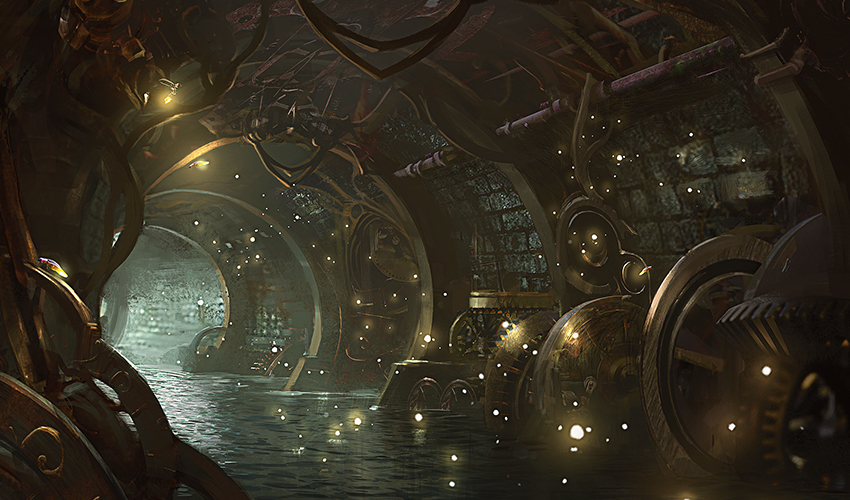
Kaladesh
This meant Kaladesh block started with a shortened exploratory design of only three months (which, interestingly, is all we have nowadays). It was quite a successful exploratory design, though, as both energy and Vehicles came out of it. (Energy was mostly in the form we used, but Vehicles was in a much rawer state.)
Kaladesh block took the basic idea we had for the block, an artifact-themed block with an inventor's feel, and ran with it. Other than some story shifting to turn it into the start of the story (the idea of the Inventor's Fair led to the idea of the Planar Bridge that would play a larger role in the arc—it's what Bolas uses to transport his Eternal army to Ravnica), not much changed from our original idea for the block.
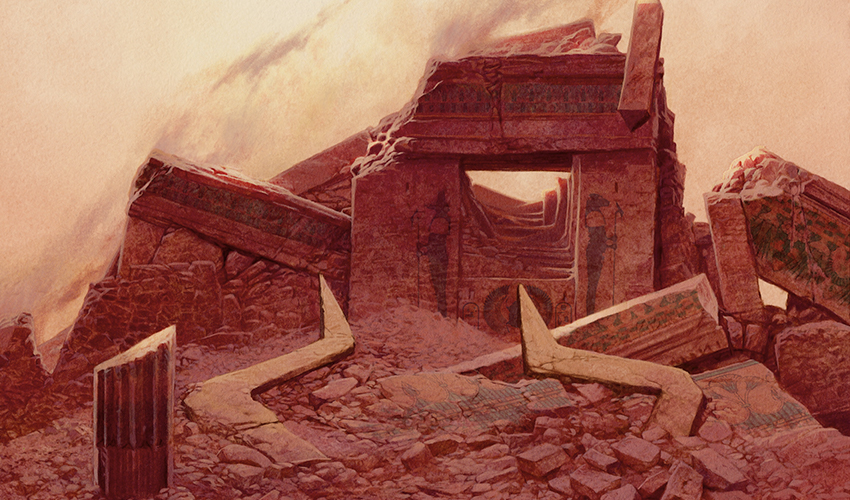
Amonkhet Block (Take Two)
We picked back up where we had stopped exploratory design three months earlier. The Creative team had gone all-in on this being a Plane crafted by Bolas. This led Vision Design to focus on the idea of designing a disconnect between the mechanics and the creative to create the feel of dissonance. The mechanics would play up the cruelty of the world and the feel of Bolas, whereas the creative would show things as being bright and happy. This led us to use -1/-1 counters and mechanics like exert.
As predicted, Vision Design struggled to make individual top-down card designs, as the source material just wasn't as well known. We leaned heavier on capturing larger tropes through mechanics, which ended with us doing things like embalm, mummy (Zombie) tribal, the pyramids with brick counters, and "deserts matter" cards.
Like with Kaladesh block, Amonkhet block mostly followed the path we'd predicted for it. The tone ended up a bit harsher than we'd predicted, and the mechanics ended up more complicated than we, in retrospect, were happy with.

Ixalan Block
This block ended up deviating the most from what we'd planned for it. A few months before Ixalan exploratory design was scheduled to begin, Shawn Main approached me about a mechanic they were playing with in Conspiracy: Take the Crown called monarch. He realized that it was playing in exactly the design space I'd cordoned off for Ixalan block. I told him that he could continue exploring it, but he should get a backup mechanic. Meanwhile, I'd started Ixalan exploratory design early so we could play with the edge mechanic to see if it worked well in two-player play. If it did, we were going to save it for Ixalan, as a main Standard-legal set had priority over a supplemental set (based on things like sales potential). We'd get together in six weeks and talk.
We did the exploratory design playtesting, and the mechanic worked well in two-player play, so I went back to Shawn and told him that he'd need to give up on the monarch mechanic. Shawn said that they hadn't found a good backup mechanic and really wanted to keep monarch. This ended up being escalated to Aaron, who decided to let Conspiracy: Take the Crown keep monarch as its design was ending and it needed it. I had a whole vision design process to figure out something else for Ixalan.
When we started working on vision design, the Creative team had done what I'd asked and created a third faction for the world, Pirates. They'd also fleshed out the natives to include Dinosaurs. It became clear as I worked on the set in vision design that the two most compelling aspects of the set were the Pirates and the Dinosaurs. While both had existed before, neither had ever been done in enough volume to build a deck around. Ixalan block would change that. That's when I realized that we could turn Ixalan into a tribal block. (We hadn't done a major one since Lorwyn block.) It would require making Dinosaur a new creature type and adding a fourth faction. I used a four-faction model I'd originally created for Khans of Tarkir back when it was only four factions—two three-color factions and two two-color factions.
Of all the blocks, this one deviated the furthest from our first meeting. While the vampire conquistadors were still there, other facets of the Plane definitely took center stage, and mechanically, it was completely different than what we'd originally pitched.

Dominaria Block
Dominaria block was probably the biggest challenge we'd taken on (well, that or the Planeswalker war). We walked out of exploratory design with the idea of focusing on history as a theme. Figuring out how to pull that off would take all of vision design (and even then, extend well past it as my fight to keep historic in the set lasted for over a year). The Creative team settled on the idea of the Plane being in rebirth and found a cool way to visually incorporate "a Plane whose present is defined by its past."
In the middle of the chaos of solving this puzzle, we had another obstacle thrown our way. R&D had decided to shift from the two-and-two model to a three-and-one model (three large sets with a core set). This meant that the small set that was to accompany Dominaria disappeared and turned into a core set (Core Set 2019). We had to scramble and pull in elements of the small set into the large set and let others (like Knight tribal) go. The Creative team had probably the larger task of condensing the Dominaria block story down to just one set.
In the end, we got something we were very proud of, and it definitely matched what we had said we wanted at that first meeting, but it took a huge amount of work to get there.

Guilds of Ravnica Block
In exploratory design, I went and talked to Aaron. We'd come up with a few ways to shake up the guild model and do things a little differently. Was this something we wanted to do? Aaron said no. The next block was going to be pretty innovative. Why don't we stick with the tried and true for this block? It will be known and comfortable. This is why we didn't innovate too much. We just focused on making a flavorful and fun set using the guild model structure everyone knew.
This set also didn't have the problems of Dominaria as it had always been planned as two large sets, so the shift to the new model didn't really affect it. Of all the Planes, this one was the closest to what we mapped out during the first meeting.

War of the Spark block
Like Dominaria, War of the Spark started out as a large set and a small set. We were in the early stages of vision design when the shift happened, so while it had a little bit of an impact, it was far less than Dominaria. The big challenge of War of the Spark was trying to bring the Planeswalker war to life. We spent the first half of the vision design (again, three months) trying to create an "event" mechanic. The idea was that there was some subgame that got overlaid on the normal game which allowed you to be carrying on a war while you played (the mechanic was called skirmish, and I talk more about it here). I eventually abandoned skirmish when I realized we'd been focusing on the wrong thing and shifted to figuring out how to make a set filled with planeswalkers.
The Creative team, meanwhile, spent a lot of time trying to figure out how to tell the story through the set. They broke it down into three acts, all during the same day, and then used the time of day to help communicate when in the story the scene took place. They also heavily used the story spotlight indicators to help players piece together the order.
The end result of the set wasn't too far from what we'd originally talked about, but like Dominaria, the act of figuring out how to pull it off was quite difficult.
And Scene
It's interesting looking back at our initial planning meeting. While we definitely were off on a few things and couldn't have anticipated some changes that would happen to the game along the way, the final product is actually pretty close to what we put together during the initial offsite. Doug and the Creative team did an amazing job weaving the story through the Planes we'd selected, and I feel that each world had a distinctive mechanical identity.
I hope you enjoyed this peek at a slightly bigger slice of how I talk about design. If you all enjoy this, perhaps I'll do it again for another multi-year slice when the time comes. As always, I'm eager for your feedback. You can email me or contact me through any of my social media accounts (Twitter, Tumblr, and Instagram).
Join me next week when I begin to share the Throne of Eldraine vision design document.
Until then, may all your plans come together close to how you planned them.
#685: Things Not Going According to Plan
#685: Things Not Going According to Plan
48:49
In game design, as in any creation—and life really—things don't always go according to plan. In this podcast, I talk about numerous times Magic design ended up having to go in a different direction.
#686: Throne of Eldraine Cards, Part 1
#686: Throne of Eldraine Cards, Part 1
44:22
This is part one of a four-part series on card-by-card design stories from Throne of Eldraine.
- Episode 684 Throne of Eldraine
- Episode 683 Throne of Eldraine Stream
- Episode 682 Connecting Set & Story

